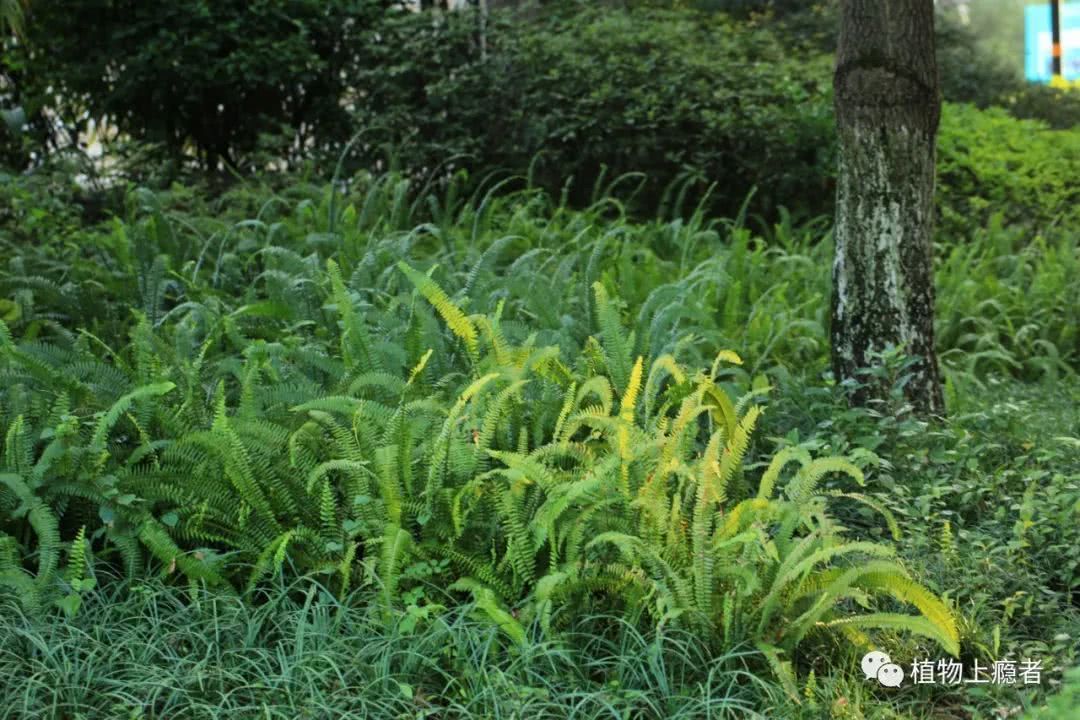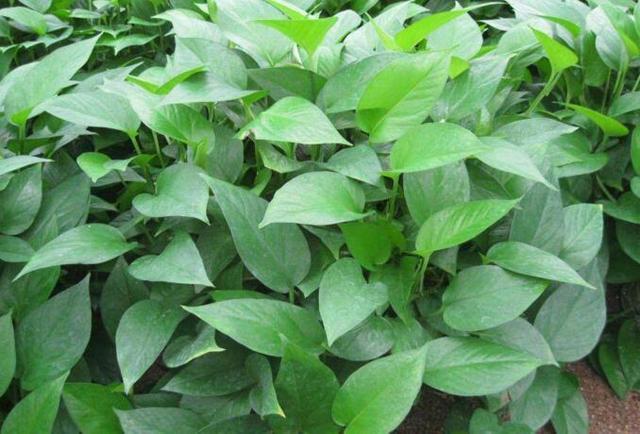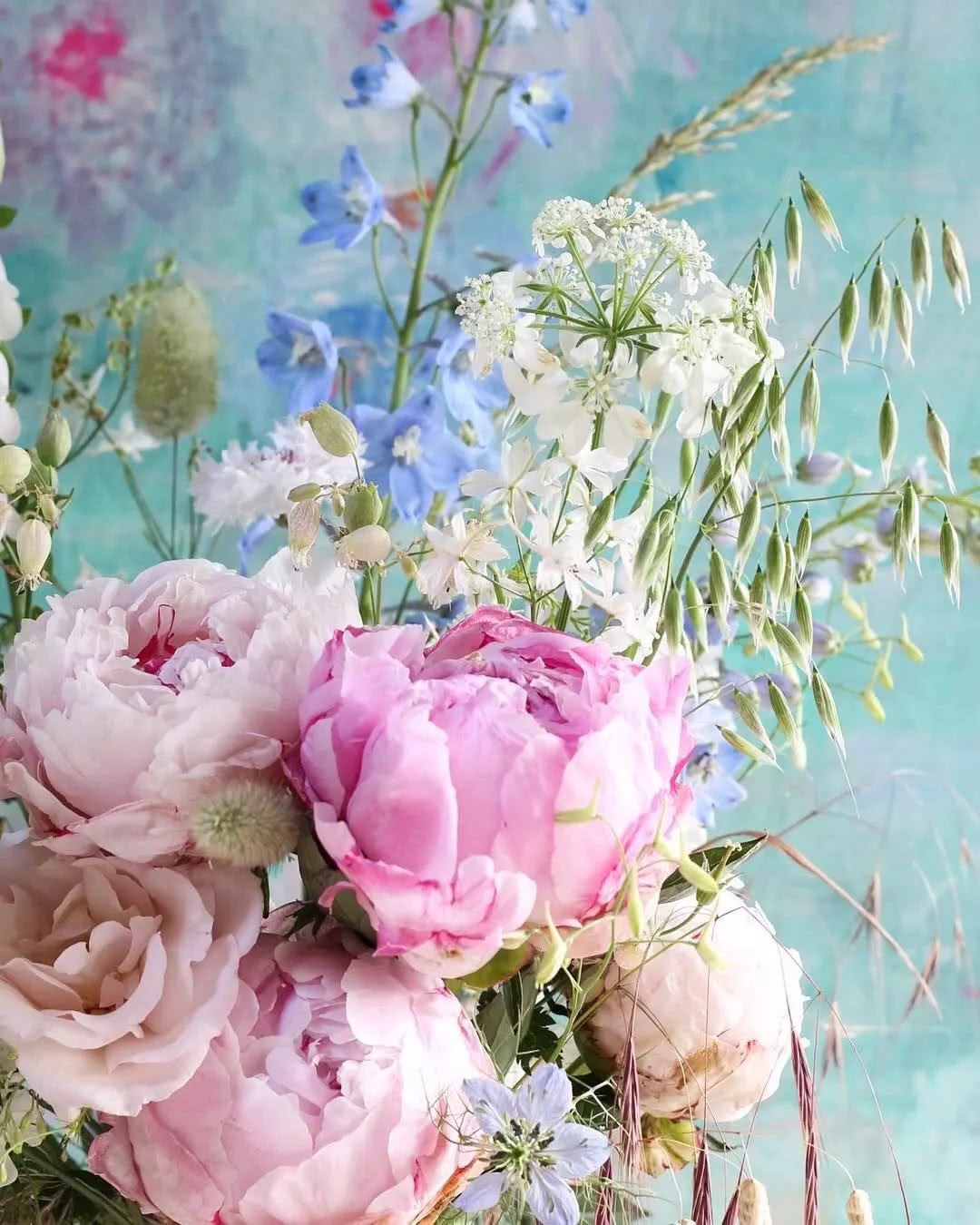Luckily, I didn't miss it because I didn't judge people by their appearance. Interesting soul.

The Beautiful Fern Lun
05
Kidney fern
Nephrolepis cordifolia
Alias: Shihuangpi, sword fern, centipede grass
Nephropteridaceae
The previously written Hai Jinsha, Guanzhong, Jinglan side grass and centipede grass are all wild ferns. Unlike kidney ferns, most of them are cultivated.
However, I didn't think kidney fern was beautiful before. It lacks the smart charm of wild ferns. Kidney fern is often used to fill the gaps in the green space of the community, or to enrich the varieties of hedges, so there is a unique dull phase of urban hedges. To make matters worse, gardeners often cut off their waist mercilessly while pruning, which is terrible to see.
But in any case, kidney fern is one of the most commonly cultivated ornamental ferns in the world, which is worth knowing.
The first is the name kidney fern, which comes from its kidney-shaped sporangia. This season, you can easily find two rows of spores on the back of its pinnae, with a light-colored cyst cover, which is also kidney-shaped. The generic name Nephrolepis consists of the Greek root nephros kidney + lepis scales, which refers to this feature.
In this season, it's easy to find spores.
The spores are kidney-shaped, also like a crescent.
The sporangia are arranged in two rows on the back of the pinnae.
It was only when I looked through my father's red book of Chinese herbal medicine that I was really interested. Kidney fern alias "stone yellow skin", "its underground root is translucent light yellow, oval, shaped like fruit yellowish skin." Chinese Flora also says, "Tuber is rich in starch, edible and medicinal." Wampee is a tropical fruit, which is not common in Chongqing. Some friends have brought it back from Guangzhou to taste it, so I have a slight impression.
Huangpiguo, taken by Yifan
Last Saturday, I pulled up four kidney ferns in the community, but I didn't find the stone yellow peel. That evening, lightning and thunder and torrential rain swept away the muggy heat that had lasted for many days. The next morning, the air was very cool and pleasant, and my father and I went for a walk on the top of the hill near the neighborhood. Passing through the Mid-levels Club, there are several tall tropical landscape trees in front of the court, which are covered with kidney ferns. I stopped to take a picture and soon found that the tree was covered with round translucent gems-isn't it stone yellow? It takes no effort to get here.
This unexpected harvest made me satisfied all day. The stone yellow peel picked up is large and small, and the hands are very hard, just like a stone, but it can be easily cut in half with a fruit knife, and the water immediately flows out of the cross section, which can be called "water in the outer stone". Who invented the wonderful name Shihuangpi? I want to salute him. Hey, hey.
There is a lot of yellow bark on the tree.
When looking up the Handbook of commonly used Chinese Herbal Medicine, the entry of centipede grass actually corresponds to kidney fern, rather than the centipede grass written in the previous issue. Indeed, centipede and grate are aliases for kidney ferns. These two kinds of ferns are odd-pinnate compound leaves, which are not difficult to distinguish in adulthood: the pinnae of kidney fern are short and dense, the pinnae of centipede are slender and sparse, and the spore morphology is completely different. The young leaves of the scrolls look completely different when they are just stretched out, but at some point in their infancy, they do look a bit alike.
The pinna of kidney fern is short and dense, and the main vein is very dark.
Pinna margin serrulate, middle pinna ca. 2 cm long
The upper base is auriculate, covering the feather shaft.
The young leaves are obviously different from Pteris vittata.
How can you tell the difference? The pinna of kidney fern has several characteristics. First, the color of the main vein is very dark, like a deep blue-purple thread, while the young pinna of Pteris vittata is pure green. Second, the base of the kidney fern is heart-shaped, and the word "cordifolia" means "heart-shaped", but the heart is oblique and eccentric. The upper side of the pinna base is usually marked by an ear-shaped bulge, arranged in an imbricate shape on the back of the leaves-like an old-fashioned tile house, one covering the other.
The most special thing about the pinna of the kidney fern is that there is a transparent water sac on the edge, just like a circle of broken diamonds, which can be seen clearly with the naked eye. The position of these "broken drills" is very exquisite. On both sides of the main vein of the kidney fern, there are pinnate lateral veins extending obliquely upward, and these lateral veins fork into small veins again, reaching near the edge of the leaves, and the "broken drill" water sac grows at the top of these small veins.
As you may have thought, the spores on the back of the kidney fern are not random, they grow at the top of one of each group of veinlets.
Broken diamond-like water sac
The location of spores and water sacs is very exquisite.
At this point, the delicate structure of the kidney fern has completely conquered me. Those kidney ferns that grow freely in the wild are much more beautiful than I have seen. The preferred environment is under the forest and by the stream. It is distributed in Yunnan, Guizhou, Xizang, Hunan, Zhejiang, Fujian, Taiwan, Hainan, Guangdong and Guangxi. It is also widely distributed in tropical and subtropical regions of the world.
I used to have a slight impression of kidney fern. I have read a book about the plants in the movie, "some Flowers make the Light and Shadow" (blue, purple and gray). One of the chapters is about the movie GREEN CARD (Green Card) and Boston Kidney Fern.
When I wrote about Kidney Fern this time, I found out how to watch this old movie. The male lead is Depardieu with a big nose, and the female lead is Andy McDowell, who starred in "four Weddings and one Funeral". Andy, a horticulturist, took a fancy to an apartment with a greenhouse, but the landlord refused a single dog; de Padiyo, a Frenchman stranded in New York, desperately needed a green card. The two people get married through fake marriage, each for his own needs. A very delicate and affectionate love film. The Boston kidney fern appears in the greenhouse of this apartment.
According to the Missouri Botanical Garden (Missouri Botanical Garden), Nephrolepis exaltata "Bostoniensis", called Boston Fern in English, is one of the most popular, well-nourished and famous indoor ferns in history. It won the reputation of "classic living room fern" many years ago. The leaves of "Boston" grow upward at first, but they bend and droop gracefully at a certain age, so they are especially suitable for growing in a gondola or placed on a high cabinet to let the leaves hang down gracefully. This breed prefers a wet environment, so it will be better in the bathroom or kitchen.
Leaf arch is the main difference between Boston and kidney fern. In addition, Nephrolepis exaltata, the original variety of Boston, is called sword fern (sword fern) and Tuberous sword fern (sword fern with tubers). I suspect that most of Boston kidney ferns have stone yellow bark.
The most famous kidney fern "Boston", pictured on the Internet
No matter how ordinary plants are, they can withstand the most fastidious scrutiny. The process of getting to know Kidney Fern is full of surprises, surprises and satisfaction, just like meeting a new plain-looking friend, but with the interaction, you find that he / she is not only knowledgeable and interesting, but also humorous and funny. At this time, you will meditate in your heart: fortunately, you didn't miss this interesting soul because you didn't judge people by their appearance.
The article and plant pictures (except for the origin) are all original by the author.
Your retweet compliment is the greatest support for me.
Plant addict
WeChat account: plantfiend
Discover the unique beauty of each plant
- Prev

It's crazy for these flowers to burst after feeding more water for 10 days in autumn.
If you want to raise flowers well, watering is the key. Water is the source of all things. If you want to water them well, will it be far away if you want to burst the pot? Especially now that autumn is coming, the weather is getting cooler and cooler, at this time, many dormancy in the summer high temperature period.
- Next

Your opening flower basket that used to cry is so foreign now?
Two days ago, there was a barber shop opening downstairs, and two rows of opening baskets were placed at the door. The barber did not kill Matt, but changed the open flower basket to kill Matt, red and green, ribbon fluttering, really ugly to see ah the times are making progress, but very.
Related
- Wuhan Hospital Iron Tree Blooming Result Was Instantly Frightened by the Gardener Master
- Which variety of camellia is the most fragrant and best? Which one do you like best?
- What is the small blue coat, the breeding methods and matters needing attention of the succulent plant
- Dormancy time and maintenance management of succulent plants during dormancy
- Minas succulent how to raise, Minas succulent plant pictures
- What are the varieties of winter succulent plants
- How to raise succulent plants in twelve rolls? let's take a look at some experience of breeding twelve rolls.
- Attention should be paid to water control for succulent plants during dormant period (winter and summer)
- Watering experience of twelve rolls of succulent plants
- Techniques for fertilizing succulent plants. An article will let you know how to fertilize succulent plants.

